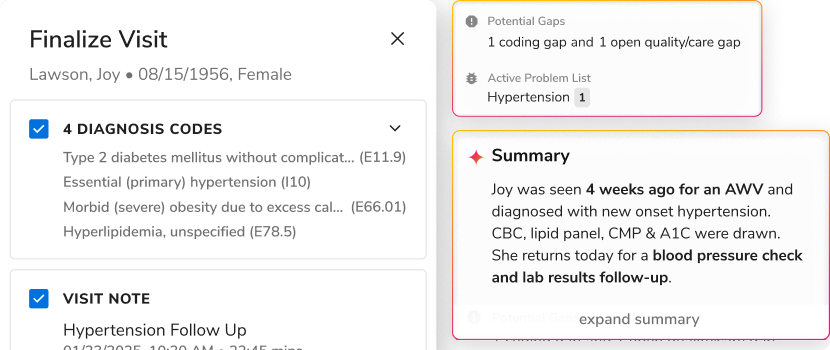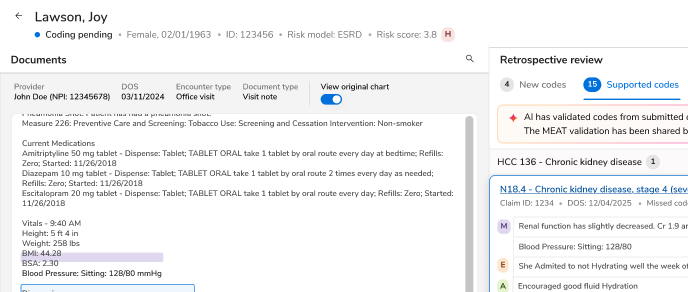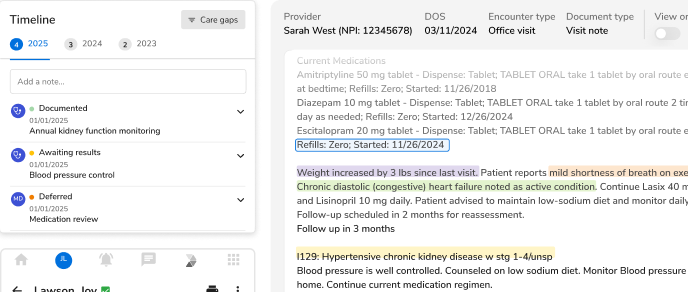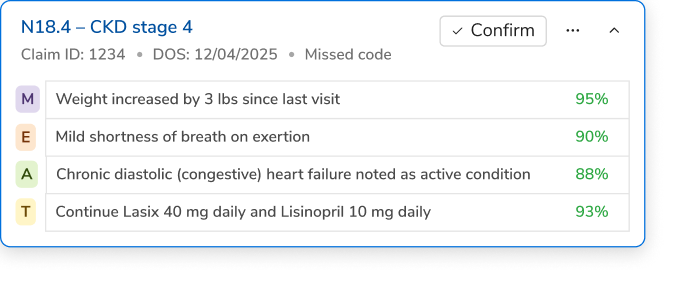What is Value-Based Care (VBC): Advantages, Challenges, and Implementation

Healthcare is shifting from its long-standing model of simply billable fees-for-service to a more patient-centered model known as value-based care. This encourages an emphasis on patients but potentially leads to reduced cost and better care. In this blog, we will discuss what value-based care is, the importance of moving from a volume to a value model, how the VBC model differs from the fee-for-service model, key principles of value-based care, and the various existing value-based purchasing programs.
What is Value-Based Care (VBC)?
Value-based care, in a broader perspective represents a delivery model within the healthcare sector centered on high-quality and efficient as well as patient-centered care. Under VBC, payment is "rewarded" to providers based on better outcomes for patients rather than through fee-for-service, wherein providers are actually paid based on the qualityof services they can offer.
In addition, for example, Centers for Medicare & Medicaid Services in 2024 increase value-based programs with new ACO models asking providers to give significant importance to outcome-based metrics rather than the volume of services.
The new figures revealed by the Health Care Payment Learning & Action Network (HCP LAN) 2024 report reflect that more than 60 percent of payments in the sector are now attributed to value-based models, mainly under Medicare Advantage.
Let’s take an example, John visits his physician multiple times for a persistent headache issue. His insurance claim summary shows that the provider was reimbursed for every service provided during each visit.
On the contrary, Peter, John’s friend, visits a different provider. However, his claims show that the provider was reimbursed on a one-time lump sum basis, based on how well the provider managed his condition on quality metrics.
In John's scenario, the provider delivered volume (of services) with little or no strings attached to quality. But Peter's provider aimed to deliver value with the best care possible to meet quality metrics and this helped Peter get improved and proper care. The introduction of the Affordable Care Act in 2010, has made provider organizations focus and shift from volume to value.
Today's State of Value-Based Care
Fig 1: The Current State of Value-Based Care (VBC)
How is Value-Based Care (VBC) Different from the Fee-For-Service (FFS) Model?
While fee-for-service focuses on the number of services rendered, VBC is centered on the quality of care provided. According to the latest 2024 CMS guidelines, providers participating in shared savings programs and advanced APMs (Alternative Payment Models) are incentivized to reduce costs while improving patient outcomes. So, it is necessary to understand how value-based care vs fee-for-service battle goes on paper to implementation.
A few ways value-based payments differ from FFS:

What are the Key Principles of Value-Based Care?
- Patient-Centered Approach: The patient is at the heart of value-based Care. It demands a clear understanding of individual patient needs, preferences, and goals. Getting a complete picture of the patient’s care journey results in better patient outcomes, reduced hospital readmissions, better chronic disease management, and improved overall health and well-being.
- Care Coordination: Collaboration between providers, payers, and patients is essential to the VBC model. It is needed before a visit, in conjunction with the visit, and after a patient's discharge. Innovations such as telehealth and AI-driven care management tools can make it easier to coordinate previsit preparation, inpatient service, and post-discharge follow-ups from the providers. Providing services post-discharge enhances patient adherence to medication, reduces the likelihood of readmissions, and enhances the quality of experience.
- Outcome-Based Incentives: Providers are incentivized no matter whether they participate in the FFS or VBC model. But as we discussed earlier, one depends entirely on the value delivered. This core principle of the value-based care model ties providers to improving patient outcomes at affordable costs. The patient outcomes can include easy access to health data, their overall experience with the provider, and other things that add value for patients.
- Focus on Prevention and Early Intervention:One of the core focuses of value-based care is keeping the patients healthy. Under the value-based care model, providers have to be proactive by focusing on preventive measures and early intervention. This is mainly intended to avoid costly and avoidable complications, that can affect any patient's care journey.
- Data-Driven Care: Data runs our world today from tracking, measuring, auditing, projections, and more. VBC also emphasizes heavily on data analytics to identify trends, patterns, and areas for improvement leveraging complete patient data. This data must be multi-level with a spectrum of insights that can be drilled down from the population level to the patient level.
What are the Different Value-Based Payment Models?
All value-based reimbursement arrangements emphasize quality over the quantity of services provided. The terms ‘value-based care’ or ‘value-based payment’ include a variety of reimbursement arrangements, including APMs (Alternative Payment Models), advanced APMs, bundled payments for episodes of care, pay-for-performance, shared savings programs, and global capitated payments.
| Pay for Performance | Healthcare providers are only compensated if they meet certain metrics for quality and efficiency. |
| APMs and Advanced APMs | APMs can apply to a specific clinical condition, a care episode, or a population. Advanced APMs are a subset of APMs and allow clinics to earn more for taking on some risks related to their patient's outcomes. |
| Bundled Payment | Under this payment structure, different healthcare providers who are treating a patient for the same or related conditions are paid an overall sum for taking care of a condition rather than being paid for each treatment, test, or procedure. In doing so, providers are rewarded for coordinating care, preventing complications and errors, and reducing unnecessary or duplicative tests and treatments. |
| Shared Savings | The shared savings program facilitates coordination and cooperation among providers to improve the quality of care for Medicare Fee-for-Service (FFS) beneficiaries and reduce unnecessary costs. Eligible providers, hospitals, and suppliers can participate in the shared savings program by creating or participating in an Accountable Care Organization (ACO). |
| Global Capitation | The global capitation system operates on the basis of a network of hospitals and physicians receiving fixed payments on a per-member basis for enrolled health plan members. Generally, providers sign a single contract with a health plan to cover care for members and then determine a method of dividing up the capitated payment among the provider group. |
What are the Key Challenges while Succeeding in Value-Based Care?
Value-based care holds great promise but comes with challenges. Moving away from the fee-for-service model entails great overhauls in healthcare IT infrastructure, including information data management protocols and payment models. Here are the biggest challenges that healthcare providers face while transitioning to value-based care:
- Lack of coordination between different providers: This is a common problem for patients who consult several specialists. These specialists usually have a different electronic record system, so it becomes difficult to get all of the information in one place at once. Not just in this scenario, coordination between providers and their care teams is also critical while managing inpatient care.
- Staffing shortages: A lot of people don't have access to healthcare because they can't afford it, but even if they do have access, there aren't enough doctors or nurses to meet their needs. In today’s value-based care paradigm, a single care manager is managing hundreds of patients. To support and enhance improve operational efficiency, the health systems face struggle in finding the right tech partner.
- Lack of healthcare-contextualized technology: There aren't enough tools available for physicians and nurses who want to do more than just treat patients. They need dedicated technology, data capabilities, additional insights and training to enable prevention of any condition at scale. Not just for providers, technology must be readily accessible to patients and payers too. For instance, doctors generally recommend patients with diabetes or high blood pressure to keep track of their numbers and check in regularly with doctors. But majority of patients struggle to track numbers, even if they do, due to technological limitations the data never reaches their charts.
The Future of Value-Based Care
Value-based care is the shift in healthcare delivery since it strives for putting patients' welfare and good quality care into the forefront. The advantages of this value-based care come with focusing on outcomes, preventive measures, and patient engagement with increased patient outcomes, cost containment, and better patient experience.
The outlook of VBC seems bright, particularly with AI, machine learning, and wearable health technologies. These innovations have enabled providers to be proactive about managing patient health, thus preventing readmissions and driving down healthcare costs.
The latest 2025 projections made by industry experts indicate that more than 75% of healthcare payments will be tied to value-based arrangements. That is, healthcare will take on a population health management approach as these models are continually adopted by healthcare systems, creating sustainable and efficient care models.

.png)





.png)









.svg)
.svg)

.svg)

